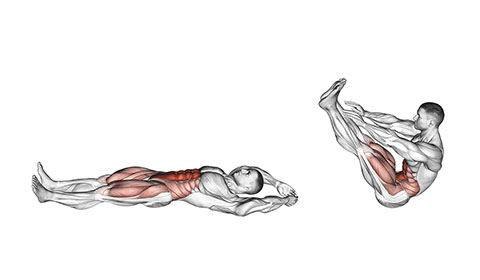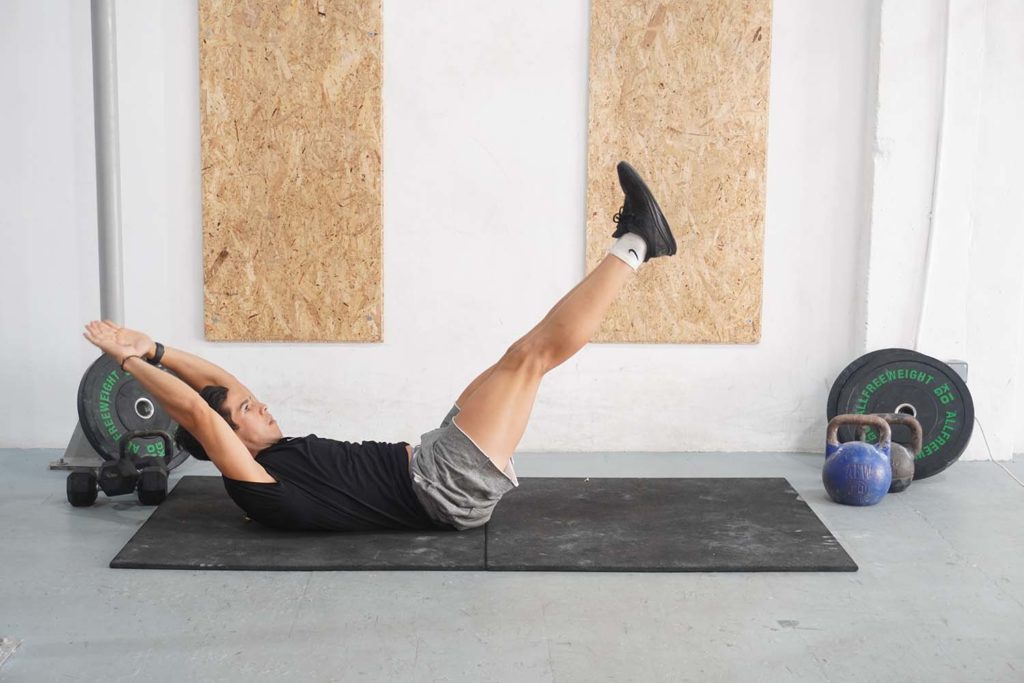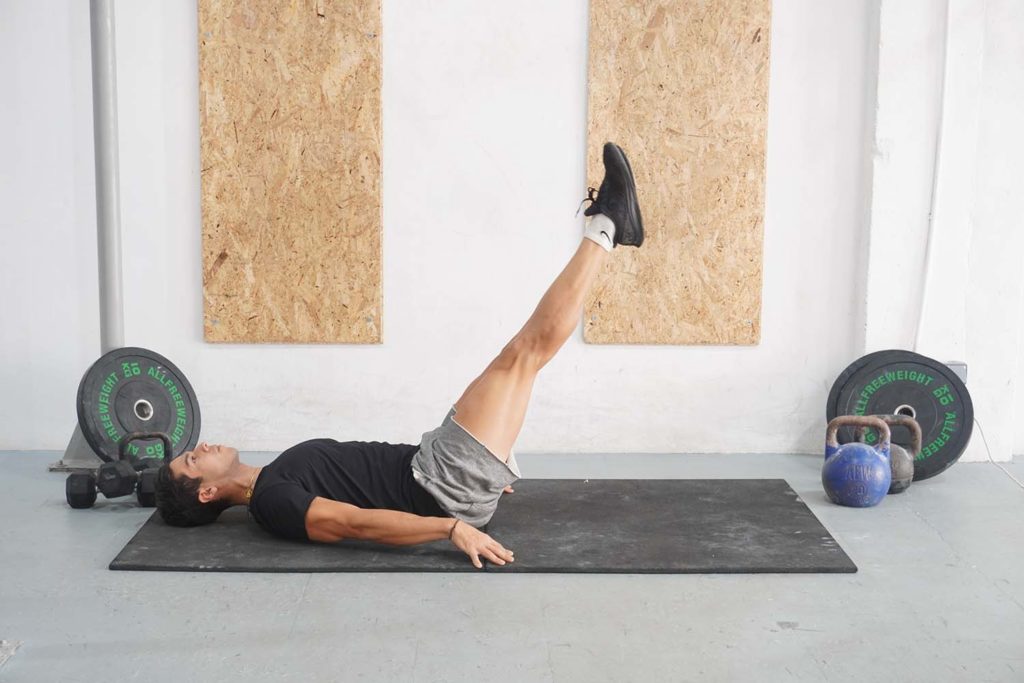What is a jackknife sit-up?
Crunches, planks, and hanging knee raises are all excellent core exercises. But doing the same exercises gets old, so trainees often find themselves frustrated with ab training. Luckily for all of us, there are countless fun and engaging movements to choose from, and jackknife sit-ups are one such example.
The jackknife sit-up is a full-body, low-impact core exercise that builds stability, strength, and, of course, a set of rock-hard abs. The movement is great because it doesn’t stress your joints, and you don’t need any equipment to do it. But despite that, jackknife sit-ups challenge us as few other exercises can.
Doing jackknife sit-ups is a fantastic way to strengthen your core, translating to better athletic performance, more stability when lifting weights, and an easier time doing everyday activities.
How to do a Jackknife Sit Up

- Lie flat on the floor with your legs straight and arms behind your head. Your heels, legs, buttocks, upper back, head, and arms should contact the floor.
- Take a breath and engage your abs.
- Simultaneously lift your arms and legs a few inches off the floor.
- Once you’re in that position, take another breath and lift your arms and legs toward one another. You should raise your legs to a 45-degree angle and have your arms almost parallel with your hands touching your shins. Exhale once you touch your shins.
- Extend your body back to the starting position without resting your hands or feet on the floor.
- Take a breath and repeat the motion.
What muscles does the jackknife sit-up activate?
The primary muscles that work during the jackknife sit-up are the abs (rectus abdominis), which span from below the chest to the lower stomach. Their primary function is to flex the torso by pulling the rib cage toward the pelvis (1). Aside from that, our rectus abdominis plays a massive role in core stability, which we need to maintain the jackknife starting position.
Our obliques (internal and external) and transverse abdominis are also involved in the jackknife sit-up. All three muscle groups contribute to core stability, allowing us to maintain our position and ‘fold’ our body on each repetition (2, 3, 4).
The legs are also involved in the jackknife sit-up. Our quadriceps keep our legs straight, and flexing our calves maintains a rigid ankle position. The posterior chain (glutes and hamstrings) contributes to raising our legs off the floor. The rectus femoris, one of four quadriceps muscles, also assists with raising our legs. The quadricep head is the only one that crosses the hip joint, which allows it to help with leg raises, aside from knee extension (5).
Progression to the Jackknife Sit-Up
The jackknife sit-up is an effective core exercise, but you might not be able to do it, especially if you’re new to ab training. Don’t worry if that is the case because you can work your way up to the full jackknife sit-up.
Start by strengthening the muscles involved in the jackknife sit-up. A well-balanced strength training routine will be more than enough in most cases. Developing your midsection and leg muscles through various exercises will make it easier to get into position and do the movement.

Aside from that, you can introduce more straightforward exercises to build up core strength and learn the movement patterns involved in the jackknife sit-up. One great movement is the lying leg raise. Since raising your legs is one part of the jackknife sit-up, learning how to do it in isolation will help. Regular sit-ups will also help strengthen your rectus abdominis.
Variations and Modifications of the Jackknife Sit-Up
1. Side Jackknife Sit-Up
Instead of lying on your back, the jackknife variation has you lie on one side. Extend your legs, press your hip into the exercise mat, and put your hand behind your head. Take a breath and simultaneously raise your upper torso and leg toward one another. The variation emphasizes your internal and external obliques.
2. Jackknife Crossover
The jackknife crossover is a variation where you raise one arm toward the opposite leg. The exercise is easier to learn and allows you to train your obliques better.
3. Jackknife Knee Raises
The jackknife knee raise is a great way to work up to the full sit-up. The primary difference is that you keep your knees bent when raising your legs toward the ceiling. Doing so makes the exercise more accessible and allows you to learn the movement pattern.
Mistakes to Avoid
The jackknife sit-up is challenging to learn and execute, so many people forget about breathing, hindering their performance. Avoid the mistake by slowing down your tempo and inhaling before each new repetition. Exhale as you reach the top and start lowering your legs and torso to the floor.
Another significant mistake related to jackknife sit-ups is doing repetitions too quickly, leading to instability and a shorter range of motion. So, do repetitions slowly, making sure to engage your midsection muscles on each repetition. You can also add a brief pause at the top position to make the movement more challenging and improve core engagement.
The third significant mistake to avoid with the movement is cutting the range of motion short, which usually comes from a lack of strength in the midsection muscles. If you find that you can’t raise your legs and torso simultaneously, go back to more straightforward exercises like lying leg (or knee) raises and sit-ups.
Similar Exercises to the Jackknife Sit-Up
Decline Crunch
The decline crunch is an abdominal exercise where you lie on a bench, anchor your feet, and crunch up. The movement is effective at training and strengthening the rectus abdominis.
Decline crunches are similar to the jackknife sit-up because the exercise makes up half of the jackknife’s movement pattern.
Lying Leg Raise

Lying leg raises are a simple bodyweight movement you can do to emphasize the lower portion of your abs. The exercise also represents the leg motion you have to do during a jackknife sit-up. The goal with leg raises is to lie on the floor and straighten your legs. You then lift your feet off the floor and begin raising and lowering your legs.
Cable Crunch
Similar to the jackknife sit-up, cable crunches are an effective movement you can do to strengthen your abs. The goal here is to grab a cable rope attachment, go down on your knees, and begin to crunch your torso against resistance. The cable crunch is effective because it offers a fantastic overloading potential, allowing you to strengthen your abs for a long time.
